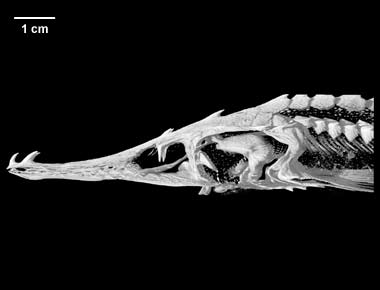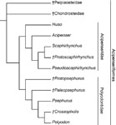The sturgeons (family) Acipenseridae, together with the paddlefishes (family Polyodontidae) and two families known only as fossils (†Chondrosteidae and †Peipiaosteidae) form the order Acipenseriformes (see Bemis et al., 1997). Acipenseriformes (Figure 1) are considered to be the living sister-group to Neopterygii (gars, bowfins, and teleosts – the group that forms over one-half of all living vertebrate species) by most recent researchers (e.g., Patterson, 1982; Grande & Bemis, 1996). |
|
Sturgeons are perhaps best known as the source of the finest caviar. They are instantly recognizable fishes, in part due to the unique presence of five rows of bony scutes that run the length of the body, and an elongate snout that is ventrally flattened and possesses four chemosensory barbels and supports a broad field of electroreceptive ampullary organs. The caudal fin is strongly heterocercal and rhomboidal scales flank its upper lobe. There are 25 living species of sturgeons classified in four genera (Scaphirhynchus, Pseudoscaphirhynchus, Acipenser, and Huso). A single monotypic fossil genus (†Protoscaphirhynchus) from the Late Cretaceous of Montana has been described. A new well preserved fossil genus, also from the Late Cretaceous of Montana, is currently under study and being described by Grande & Hilton (in progress). Many living species of Acipenseridae are difficult to distinguish anatomically (Birstein & Bemis, 1997). This may be due to factors such as natural hybridization between taxa (e.g., Acipenser gueldenstaedtii and Huso huso, Birstein et al., 1997), a high level of individual morphological variation within a taxon (e.g., A. brevirostrum, Hilton & Bemis, 1999), and that some taxa are not well-differentiated morphologically (e.g., Scaphirhynchus suttkusi and S. platorhynchus, Mayden & Kuhajda, 1996).
All extant species of sturgeons are afforded some form of protection in their native ranges, many as threatened or endangered species, yet there is very little understanding of their evolutionary history. A number of molecular phylogenies of the family Acipenseridae have been presented recently (e.g., Birstein et al. 1997; Birstein & DeSalle, 1998; Zhang et al., 2000; Ludwig et al., 2000, 2001; Fontana et al., 2001; Birstein et al., 2002), and there is substantial conflict between the results of these studies. Modern morphological analyses of relationships within the family are few and are of varying taxonomic and morphological detail (e.g., Artyukhin, 1995; Mayden & Kuhajda, 1996; Findeis, 1993, 1997), and there is still a lack of much basic morphological knowledge of the group as a whole. The monophyly of all genera (except for Scaphirhynchus) has been questioned in recent years, and there are no known synapomorphies of Acipenser, which has the most species of the four extant genera. The comparative anatomy and systematics of fossil and living sturgeons is the topic of on-going research (Hilton, Grande & Bemis, in progress).
The large Amu Darya shovelnose sturgeon (Pseudoscaphirhynchus kaufmanni) is the largest of the of three currently recognized species of the genus Pseudoscaphirhynchus, which are all relatively small sturgeons (adult lengths range from 20-75 cm depending on the species; this is in contrast to species of Huso, which historically may have reached 10 meters in length). This genus is endemic to two rivers of the Aral Sea basin in Central Asia: the Amu Darya (P. kaufmanni and P. hermanni) and the Syr Darya (P. fedtschenkoi). There are two distinct forms of P. kaufmanni: a large light colored form (Figure 2) and a smaller dark “dwarf” form (Salnikov et al., 1996; this was the form that was CT scanned). One of the proposed derived characters linking Pseudoscaphirhynchus and the North American genus Scaphirhynchus is an elongate caudal filament. This filament is best developed in P. kaufmanni (Figure 2), and is short, or even absent in the other species. One of the unusual features of P. kaufmanni is the presence of large thorn-like spines on the dorsal surface of the snout (Figures 3 and 4), although these are also found in juvenile stages of several other sturgeons (Hilton, 2005).
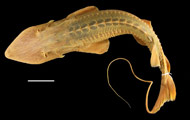 |
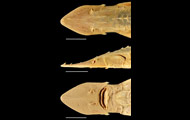 |
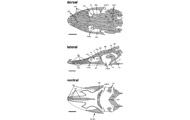 |
Figure 2 |
Figure 3 |
Figure 4 |
The three species of Pseudoscaphirhynchus are all endangered (in fact, P. fedtschenkoi may be extinct), having fallen victim to the Aral Sea ecological catastrophe (Zholdasova, 1997). The two rivers that these species inhabit no longer reach the Aral Sea due to damming for irrigation and the subsequent drying of the sea by over half of its surface area since 1960. There has also been significant pollution and other changes in the water regimes of the rivers that have heavily impacted these species, particularly P. fedtschenkoi and P. hermanni, which are found in the lower reaches of the rivers (Birstein, 1997).
Acknowledgements
My research on the anatomy and systematics of fossil and living sturgeons has been funded by the National Science Foundation (DEB-0128929, to Hilton, Grande & Bemis; DEB-0414552, to Hilton & Grande). I am grateful to the curators and staffs of the many universities, museums and institutions that I have visited and borrowed specimens from during this research. In particular, I thank Bernie Kuhajda for making available for study specimens of Pseudoscaphirhynchus for the CT scanning and other research.
Literature
Artyukhin, E. N. 1995. On biogeography and relationships within the genus Acipenser. Sturgeon Quarterly 3(2):6-8.
Bemis, W. E., E. K. Findeis, and L. Grande. 1997. An overview of Acipenseriformes. Environmental Biology of Fishes 48:25-72.
Birstein, V. J. 1997. Threatened fishes of the world: Pseudoscaphirhynchus spp. (Acipenseridae). Environmental Biology of Fishes 48:381-383.
Birstein, V. J. and W. E. Bemis. 1997. How many species are there within the genus Acipenser? Enviironmental Biology of Fishes 48:157-163.
Birstein, V. J., and R. DeSalle. 1998. Molecular phylogeny of Acipenserinae. Molecular Phylogenetics and Evolution 9:141-155.
Birstein, V. J., R. Hanner, and R. DeSalle. 1997. Phylogeny of the Acipenseriformes: cytogenetic and molecular approaches. Environmental Biology of Fishes 48:127-156.
Birstein, V. J., P. Doukakis, and R. DeSalle. 2002. Molecular phylogeny of Acipenseridae: Nonmonophyly of Scaphirhynchinae. Copeia 2002:287-301.
Findeis, E. K. 1993. Skeletal anatomy of the North American shovelnose sturgeon Scaphirhynchus platorynchus (Rafinesque, 1820) with comparisons to other Acipenseriformes. Ph.D. Thesis, University of Massachusetts, Amherst.
Findeis, E. K. 1997. Osteology and phylogenetic relationships of recent sturgeons. Environmental Biology of Fishes 48:73-126.
Fontana, F., J., Tagliavini, and L. Congiu. 2001. Sturgeon genetics and cytogenetics: recent advancements and perspectives. Genetica 111:359-373.
Grande, L., and W. E. Bemis. 1991. Osteology and phylogenetic relationships of fossil and Recent paddlefishes (Polyodontidae) with comments on the interrelationships of Acipenseriformes. Society of Vertebrate Paleontology Memoir 1:i-vii, 1-121.
Grande, L., and W. E. Bemis. 1996. Interrelationships of Acipenseriformes, with comments on "Chondrostei," pp. 85-115. In Stiassny, M. L. J., L. R. Parenti and G. D. Johnson (eds.), Interrelationships of Fishes. Academic Press, San Diego.
Grande, L., F. Jin, Y. Yabumoto, and W. E. Bemis. 2002. †Protopsephurus liui, a well-preserved primitive paddlefish (Acipenseriformes: Polyodontidae) from the Early Cretaceous of China. Journal of Vertebrate Paleontology 22:209-237.
Hilton, E. J. 2005 Observations on the skulls of sturgeons (Acipenseridae): shared similarities of Pseudoscaphirhynchus kaufmanni and juvenile specimens of Acipenser stellatus. Environmental Biology of Fishes 72:135–144.
Hilton, E. J., and W. E. Bemis. 1999. Skeletal variation in shortnose sturgeon (Acipenser brevirostrum) from the Connecticut River: Implications for comparative osteological studies of fossil and living fishes, pp. 69-94. In Arratia, G. and H.-P. Schultze (eds.), Mesozoic Fishes 2 – Systematics and Fossil Record. Verlag Dr. Pfeil, Munich.
Ludwig, A., B. May, L. Debus, and I. Jenneckens II. 2000. Heteroplasmy in the mtDNA control region of sturgeon (Acipenser, Huso and Scaphirhynchus). Genetics 156:1933-1947.
Ludwig, A., N. M. Belfiore, C. Pitra, V. Svirsky, and I. Jenneckens II. 2001. Genome duplication events and functional reduction of ploidy levels in sturgeon (Acipenser, Huso and Scaphirhynchus. Genetics 158:1203-1215.
Mayden, R. L., and B. R. Kuhajda. 1996. Systematics, taxonomy, and conservation status of the endangered Alabama sturgeon, Scaphirhynchus suttkusi Williams and Clemmer (Actinopterygii, Acipenseridae). Copeia 1996:241-273.
Patterson, C. 1982. Morphology and interrelationships of primitive actinopterygian fishes. American Zoologist 22:241-259.
Salnikov, V. B., V. J. Birstein, and R. L. Mayden. 1996. The contemporary status of the two Amu Darya River shovelnose sturgeons, Psuedoscaphirhynchus kaufmanni and P. hermanni. Sturgeon Quarterly 4:10-14.
Zhang, S., Y. Zhang, X. Zheng, Y. Chen, H. Deng, D. Wang, Q. Wei, Y. Zhang, L. Nei, and Q. Wu. 2000. Molecular phylogenetic systematics of twelve species of Acipenseriformes based on mtDNA ND4L - ND4 gene sequence analysis. Science in China Series, C Life Sciences, 43:129-137.
Zholdasova, I. 1997. Sturgeons and the Aral Sea ecological catastrophe. Environmental Biology of Fishes 48:373-380.




